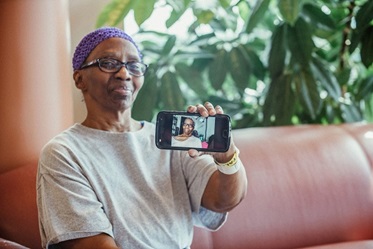A Selfie Saved Her Life

Juanita Branch’s selfies may have saved her life, according to her medical team at Henry Ford Macomb Hospital.
The 63-year-old snapped away with her phone in her Fraser home, planning to update her Facebook page. But when she looked at the screen to pick the best picture, she was surprised to see her lips twisting and her face drooping.
Suspecting she was having a stroke, she called for help in her senior apartment complex. She unlocked the front door and even tried to change her outfit, but she began to lose her balance. By the time help arrived, her speech began to slur. An ambulance brought her to Henry Ford Macomb Hospital – and to Emergency Room doctor Jason Muir, the hospital’s “Stroke Champion,” responsible for reviewing and sharing best stroke treatment practices.
“We asked Juanita what she had been doing when she began to notice symptoms,” said Dr. Muir. “From the time stamp on her selfie photos, we were able to determine that Juanita was within the 4-hour window to receive the clot-busting stroke drug tPA. The faster a stroke patient receives tPA, the better their outcomes can be.”
During a stroke, the brain loses seven million neurons a minute. When brain cells die, permanent damage can occur, so there is no time to lose in seeking medical treatment.
According to the American Heart Association, stroke is the fourth leading cause of death in the U.S. On average, someone suffers a stroke every 45 seconds and someone dies of a stroke every three minutes.
“If I had been sitting on the couch watching TV, I might have never realized I was having a stroke,” said Juanita, who spent time at the hospital’s inpatient rehabilitation unit before returning home. “I never felt any pain. But when I noticed the drooping, I knew I needed to call for help.”
Juanita had suffered a mini-stroke two years earlier, so she was aware of the symptoms. Doctors recommend everyone remember “FAST:”
- Face: Check for drooping or contortion of the face or lips
- Arms: Raise both arms; one may sink lower if experiencing stroke
- Speech: Listen for slurred or confused speech
- Time: Call for help immediately if stroke is suspected. Earlier treatment can mean better outcomes.
Juanita hopes that by sharing her experience with others, she can raise awareness of symptoms of stroke – and help someone else quickly get the lifesaving treatment they need.
.svg?iar=0&hash=F6049510E33E4E6D8196C26CCC0A64A4)

/hfh-logo-main--white.svg?iar=0&hash=ED491CBFADFB7670FAE94559C98D7798)